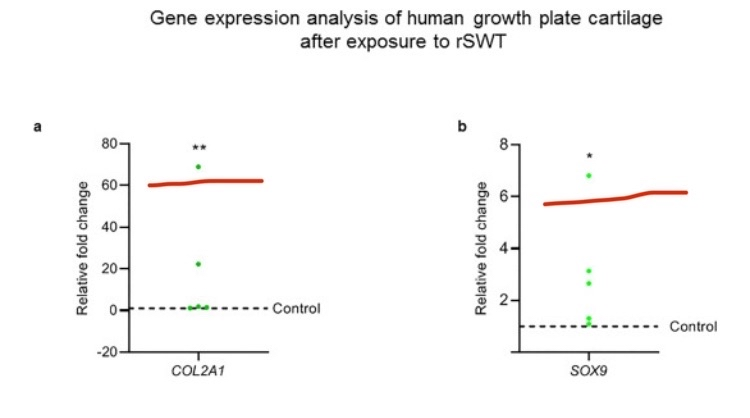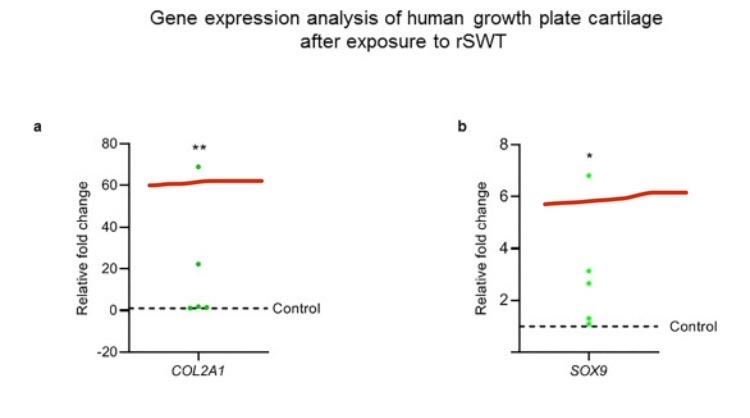ihatemySOST
Iron
- Joined
- Sep 5, 2025
- Posts
- 94
- Reputation
- 66
No, in reality, I didn’t exaggerate in the title of the post. I was actually thinking a lot about whether I should share this method or keep it as gatekeeping, because this method could be the best way ever to increase height (I’m not exaggerating; if you read this post in full, you’ll understand that I am 100% correct)
Enough yapping, whats the method? Its called rSWT ( radial shock wave therapy)
Radial shock wave therapy (RSWT) is effective because it generates extremely short pressure pulses that propagate radially from the skin surface into the underlying tissues. These pulses are not limited to pressure alone; they produce a combination of forces, including compression, tension, shear, microstreaming in fluids, and sometimes tiny bubbles (microcavitation). This combination subjects chondrocytes and other cells to a strong and sudden mechanical shock.
Cells possess specialized mechanoreceptors, such as Piezo and TRP channels, as well as integrin clusters and focal adhesions. These receptors respond directly to changes in pressure and tension by opening calcium channels or transmitting signals to the cytoskeleton. Mechanical deformation also triggers the release of extracellular ATP, which binds to purinergic receptors and amplifies signaling. Within minutes, these signals converge on central molecular pathways, including MAPK (ERK, MEK, p38), NF-κB, YAP/TAZ, RhoA GTPase, and Nrf2, whose activities can increase several-fold. This, in turn, activates genetic programs responsible for cell proliferation, protection from apoptosis, and stimulation of growth factors such as IGF-1, PTHrP, and Gli1.
The ultimate result is a rapid and noticeable increase in chondrocyte proliferation and hypertrophy, thickening of the growth plate, and stimulation of longitudinal bone growth. What distinguishes RSWT is that it covers a relatively wide area and delivers a very short, complex mechanical pulse, causing cells to respond as if presented with a “strong, unavoidable signal.” This explains the potency of its effects compared to traditional mechanical stimuli.
Sources:
• https://pubmed.ncbi.nlm.nih.gov/34238028/
• https://stemcellres.biomedcentral.com/articles/10.1186/s13287-020-02076-w
• https://pubmed.ncbi.nlm.nih.gov/37303680/
Lets move into clinic studies
Study 1:
Researchers utilized fetal rat metatarsal bones and subjected them to various frequencies and intensities of radial extracorporeal shock wave therapy (rESWT). For our discussion, we’ll focus on the most effective parameters:
• Shock Wave Parameters:
• Frequency: 10 Hz
• Energy: 180 mJ
• Number of Pulses: 500
• Session Duration: 50 seconds
A single application of rESWT was administered, and the effects were assessed after 14 days by measuring bone length and analyzing gene expression
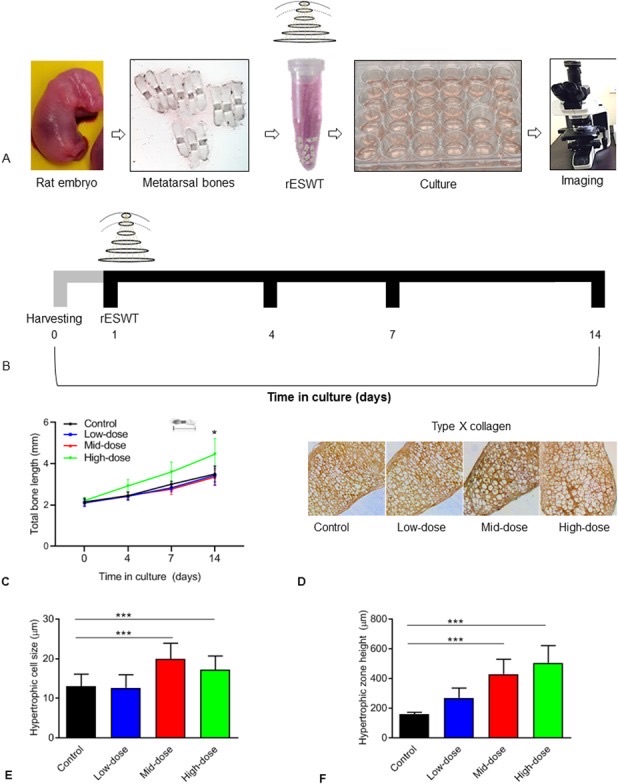
The bone length in the control group was 3.50 mm ± 0.38 mm, whereas in the high-dose group after a single application of rESWT, it increased to 4.46 mm ± 0.75 mm, representing an approximate 27% increase. This is considered a very large increase, especially given that the treatment was applied only once.
Interestingly, this increase was observed only in the group that received the high-energy treatment.
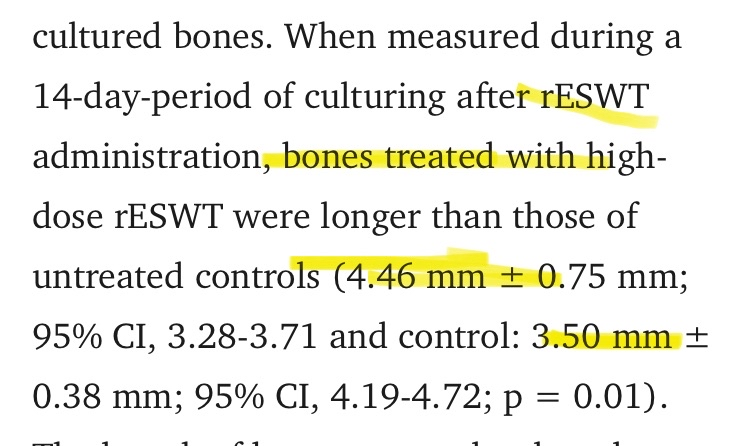
The hypertrophic chondrocyte size in the control group was 13 μm ± 3 μm, whereas after high-dose rESWT it increased to 18 μm ± 3 μm, representing an approximate 38% increase.
Furthermore, the mean height of the hypertrophic zone was 159 μm ± 13 μm in the control group, and after high-dose rESWT it increased to 505 μm ± 117 μm, representing an approximate 217% increase, which is considered extremely large.
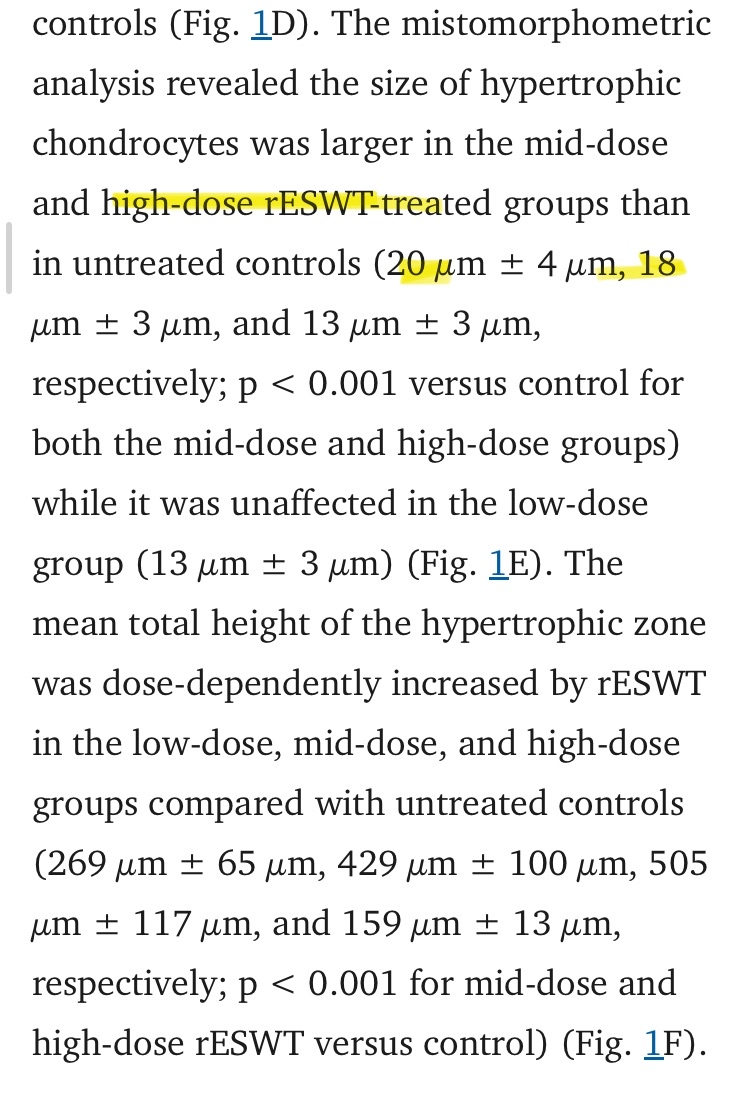
The number of proliferating cells in the growth plate of the control group was 500 ± 412 cells, whereas after high-dose rESWT it increased to 1363 ± 393 cells, representing an approximate 173% increase.
Meanwhile, the number of Bcl-2–positive cells (proteins that protect chondrocytes from apoptosis) was 35 ± 11 cells per bone in the control group, and increased to 718 ± 86 cells after high-dose rESWT, representing an approximate 1950% increase, which is an extremely large increase.
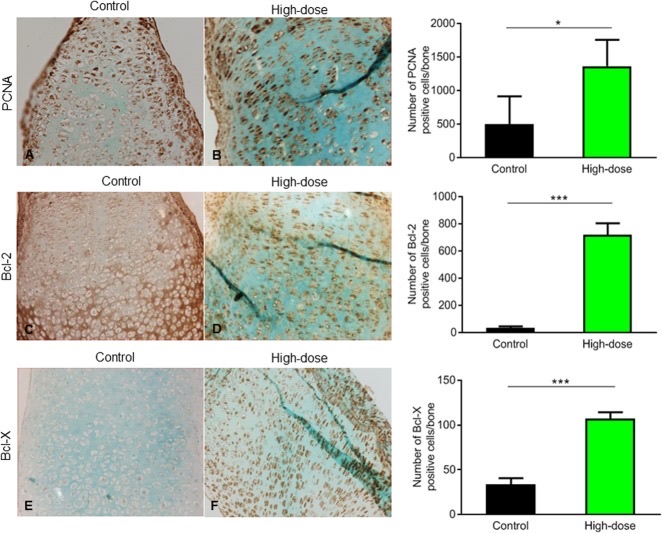
The level of NF-κB (a gene critically important for longitudinal bone growth) in the control bones was 350 ± 60 positive cells per bone, whereas after high-dose rESWT it increased to 1029 ± 262 cells, representing an approximate 194% increase.
Similarly, the level of Insulin-like Growth Factor 1 (IGF-1), one of the most important factors for chondrocyte proliferation and hypertrophy, was 270 ± 121 cells in the control group, and increased to 1015 ± 322 cells after high-dose rESWT, representing an approximate 276% increase
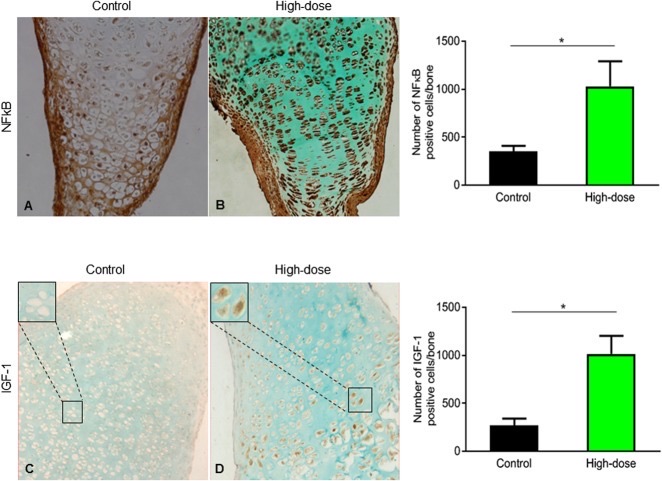
Regarding Gli1 (the glioma-associated gene 1), in control bones the number of positive cells was 442 ± 235 cells per bone, whereas after high-dose rESWT it increased to 2812 ± 2139 cells, representing an enormous ~536% increase. Gli1 follows Hedgehog signaling, promoting chondrocyte proliferation and supporting their differentiation into bone, thereby directly contributing to longitudinal bone growth.
As for PTHrP (parathyroid hormone-related protein), in the control group it was 21 ± 35 cells, whereas after high-dose rESWT it increased to 1632 ± 493 cells, an extraordinary ~7660% ( 77x fold!!!) increase. PTHrP functions to maintain chondrocytes in the proliferative stage, preventing their premature transition into hypertrophic cells, thereby keeping the growth plate active for a longer period and supporting increased bone length
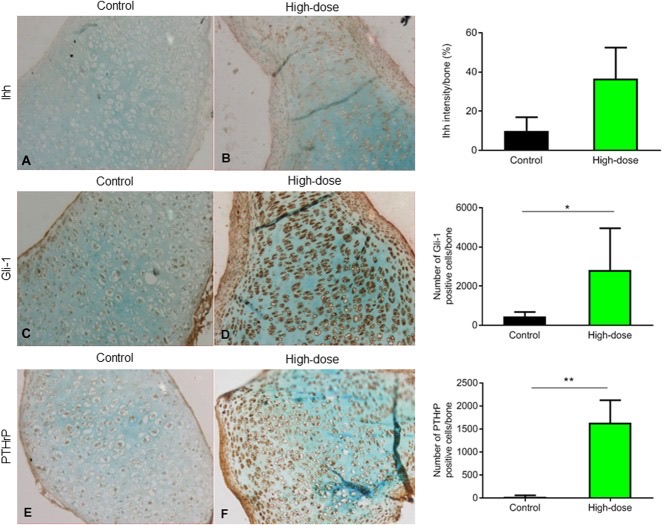
Interestingly, the bones exposed to high-energy rSWT were virtually protected from chondrocyte apoptosis, largely because the proteins that safeguard chondrocytes from programmed cell death, such as Bcl-2, increased by tens of times

This finding is also supported by other studies, where scientists genetically modified chondrocytes to overexpress Bcl-2. In these cases, the chondrocytes became resistant to apoptosis, confirming the protective role of Bcl-2 against programmed cell death.
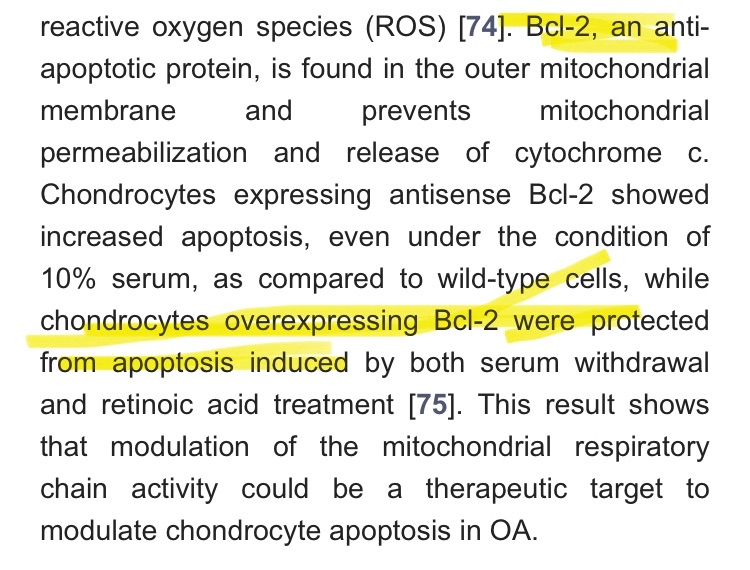
( which literally stop growth plates of closing )
Study link : https://pmc.ncbi.nlm.nih.gov/articles/PMC7145076/
This may sound crazy , huh?
You’ll wonder for yourself how just 50 seconds of radial shock wave can cause all these incredible changes in gene expression, but science is science, and every time it amazes us
In another study on ex vivo cultured bones, the bones were exposed to a drug called vismodegib, which is a potent anti-cancer agent that strongly inhibits the Indian Hedgehog (Ihh) signaling pathway. The problem is that this pathway is critically important for longitudinal bone growth, arguably one of the most essential factors. In children, the use of vismodegib has been associated with severe growth retardation:
> The hedgehog antagonist vismodegib is an effective anti-cancer treatment but unfortunately induces irreversible growth arrests and growth impairment, limiting its use in skeletally immature patients.
The researchers came up with an idea: why not try radial shock wave therapy (rSWT)? The results were truly remarkable. The study design included three groups:
1. Control group
2. Vismodegib-treated group
3. Vismodegib + single rSWT treatment group
In the vismodegib-only group, there was severe growth inhibition compared to the control group. Interestingly, just one session of rSWT nearly restored growth to normal or partial levels, effectively preventing the growth failure caused by vismodegib
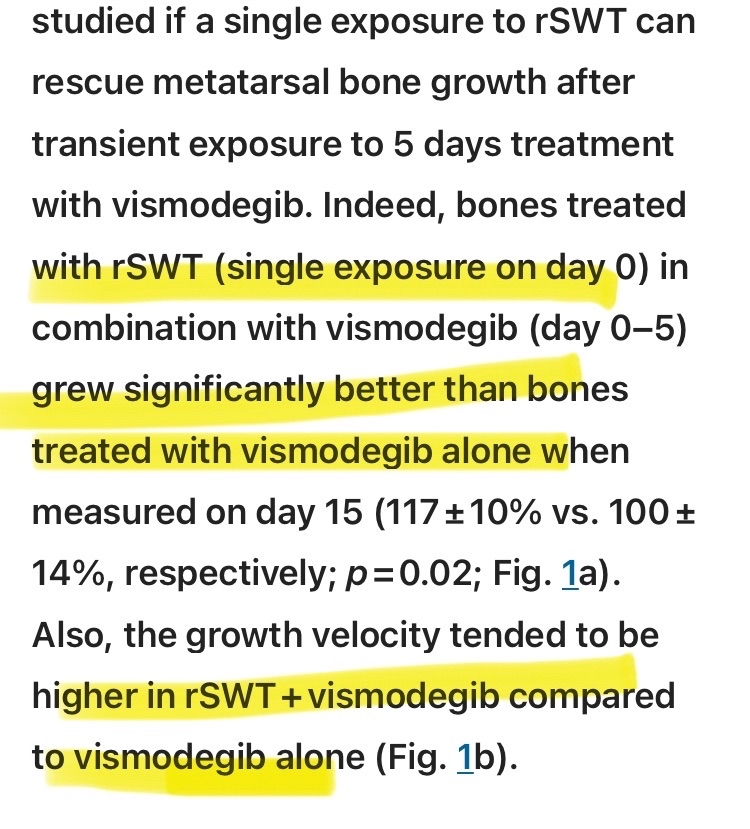
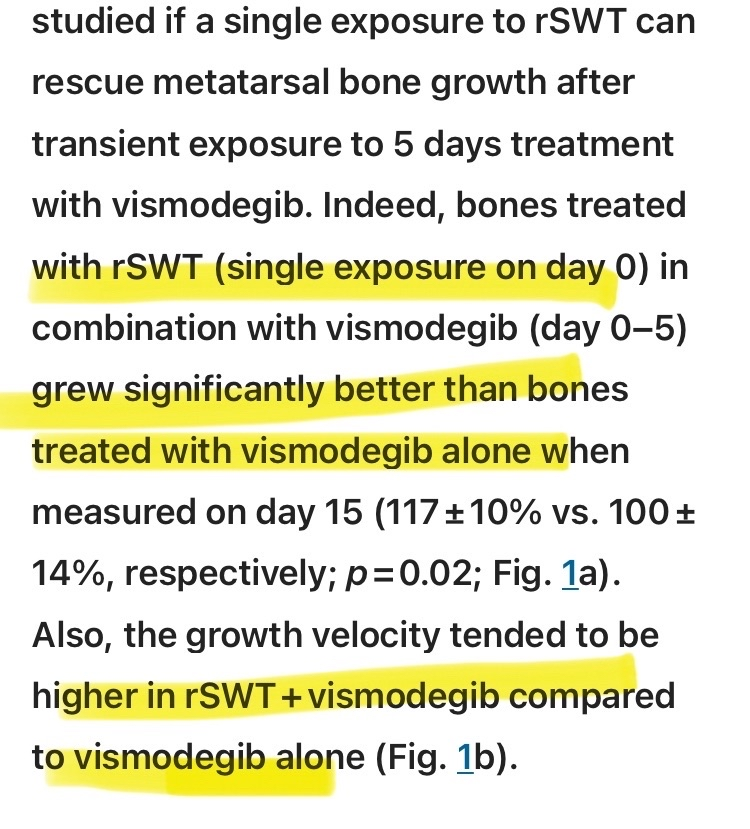
Study link : https://www.nature.com/articles/s41598-020-69904-0
Crazy, right? But now lets talk about study even 10x more crazy
Now, let’s discuss this study, which produced truly remarkable results. The researchers used three different models, and we will focus on the first one here.
First model: cartilage discs from adolescent children
> The cartilage discs (n = 5 per patient), placed in an Eppendorf containing culture medium, were exposed to high-energy rSWT (1000 impulses, 180 mJ, 10 Hz) (Fig. 1a). After exposure to rSWT, samples were transferred back to the 24-well plate and cultured for 24 h (Fig. 1b).”
They used settings of 1000 impulses, 10 Hz, high energy 180 mJ, with a total application time of approximately 1 minute and 40 seconds. Simply put, after exposing the samples to rSWT for 1 minute and 40 seconds, they measured gene expression changes in SOX9 and COL2A1 after 24 hours.
Results: The effects were literally spectacular. In one of the samples, SOX9 expression increased sevenfold, and COL2A1 increased nearly seventyfold. Not all samples showed such extreme results; the variability was likely due to the very short exposure time and the fact that some samples were highly sensitive to mechanical stress.
“After exposure to rSWT, gene expression analysis was performed after 24 h of culture. We observed increased expression of SOX9 (mean fold change: 3.0 ± 2.3; p = 0.0037, Fig. 3a) and COL2A1 (mean fold change: 19.0 ± 29.26; p = 0.0075, Fig. 3b) in treated samples when compared to untreated controls (fold change: 1.0).”
Interpretation: These increases are extremely meaningful. They indicate that the cartilage, instead of moving toward calcification (growth plate closure) and halting chondrocyte proliferation for ossification, was essentially reverted to a proliferative stage after just 1 minute and 40 seconds of rSWT exposure. This is truly remarkable, especially given the very short exposure time
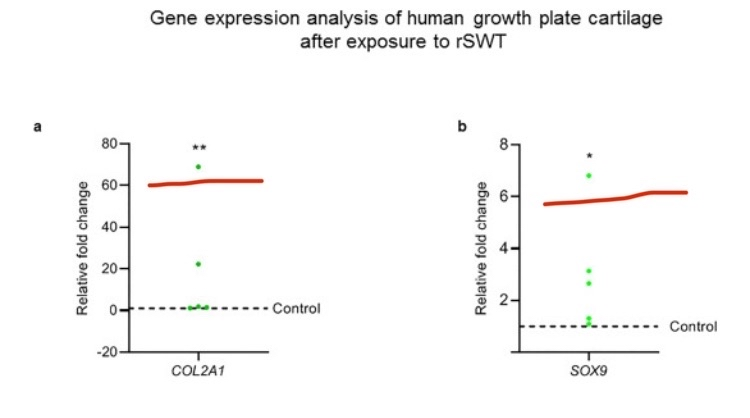
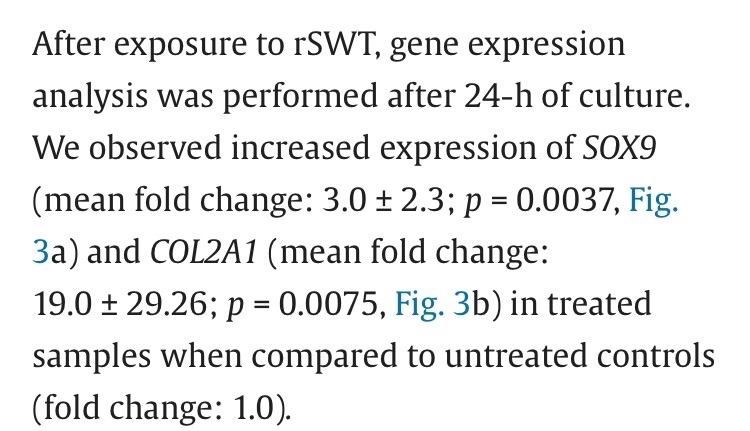
Second model: 4-week-old rabbits
“Via a 15 mm applicator tip using ultrasound gel, animals received low-energy (1500 impulses, 90 mJ, 5 Hz, n = 4) or high-energy rSWT (3000 impulses, 180 mJ, 5 Hz, n = 4) at weekly intervals for four weeks, applied symmetrically on the medial and lateral sides of the right distal femoral growth plate, while the untreated lower limb served as a control. The more beneficial and safer dose of the two was selected for the longitudinal study. Animals were sacrificed at 14 weeks of age (4 weeks after the last rSWT dose). The distal femur was chosen as it is fast-growing and lacks an apophysis, which could have introduced errors during histomorphometric measurements. The primary outcome of the histological study was to assess cellular changes in the resting, proliferative, and hypertrophic zones after rSWT.”
Results (high-energy group only):
• The chondrocyte column density (columns per mm growth plate width) in the proliferative zone was significantly increased in the high-energy rSWT group (51 ± 13) compared to the control (37 ± 3; p = 0.0005).
• The height of the growth plate also increased significantly.
• Chondrocyte proliferation increased by approximately 50%.
The treatment was applied once weekly for four weeks, with each session lasting approximately 10 minutes. Four weeks after the last treatment, results showed that chondrocyte density in the proliferative zone increased by approximately 38%, proliferation increased by ~50%, and the growth plate height increased noticeably.
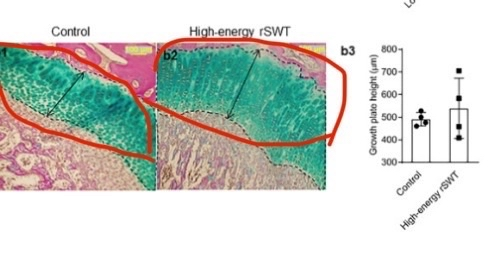
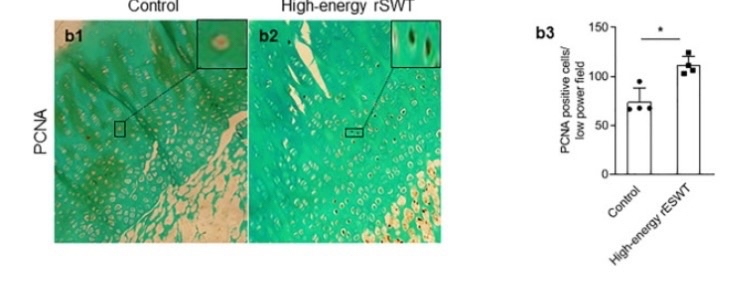
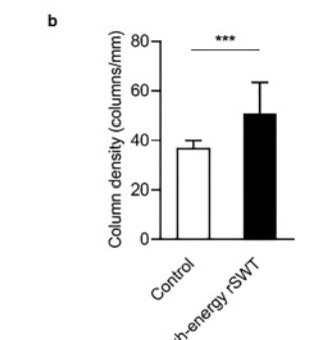
Now, let’s talk about the most remarkable result of all:
Study details:
The researchers used 22-week-old rabbits and applied high-energy rSWT. The treatment was applied to the proximal tibial growth plate. Interestingly, by 16 weeks of age, white rabbits have already achieved about 94% of their final tibial length:
“The mean tibial length at 2 weeks was 38% of the adult length, and 94% of the adult value was achieved by 16 weeks old “
> https://pubmed.ncbi.nlm.nih.gov/3712130/
This means that at 22 weeks, the growth plate was almost closed, with the tibia reaching approximately 98–99% of its final length.
Remarkable finding: Despite this, just four sessions of high-energy rSWT significantly increased tibial length, even though the treatment was applied to only one growth plate:
“At 26 weeks of age, after four sessions (at weekly intervals) of high-energy rSWT, there was a significant increase in the differences between the lateral tibial length measured on radiographs when compared to untreated controls (mean difference: 0.28 cm; p = 0.008).”
The average increase was 0.27 which represents approximately 7.5% growth over the treatment period of one month:
“We found differences up to 2.7 mm after a one month treatment period. Interestingly, during the rSWT application period, up to a 7.5% growth difference was observed.”
These results are truly extraordinary, especially considering that the rabbits were structurally near mature. Another important point is that mechanical stimulation applied to one limb can slightly affect the growth of the other limb, as seen in other studies ( please refer to lsjl) This means that if a second control group were measured, the effective increase could potentially reach 10%.
All of these amazing effects were achieved with just four sessions, and applied to only one growth plate. Imagine the potential if rSWT were applied to multiple growth plates simultaneously!
(See the figure below for a clear visual difference )
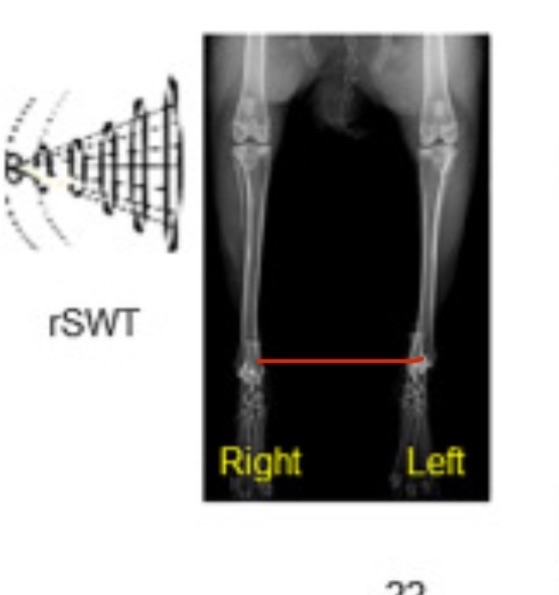
Study link :https://www.sciencedirect.com/science/article/pii/S8756328221003525
Please share ur opinion , and if anyone interested i will make guide how to do it
Enough yapping, whats the method? Its called rSWT ( radial shock wave therapy)
Radial shock wave therapy (RSWT) is effective because it generates extremely short pressure pulses that propagate radially from the skin surface into the underlying tissues. These pulses are not limited to pressure alone; they produce a combination of forces, including compression, tension, shear, microstreaming in fluids, and sometimes tiny bubbles (microcavitation). This combination subjects chondrocytes and other cells to a strong and sudden mechanical shock.
Cells possess specialized mechanoreceptors, such as Piezo and TRP channels, as well as integrin clusters and focal adhesions. These receptors respond directly to changes in pressure and tension by opening calcium channels or transmitting signals to the cytoskeleton. Mechanical deformation also triggers the release of extracellular ATP, which binds to purinergic receptors and amplifies signaling. Within minutes, these signals converge on central molecular pathways, including MAPK (ERK, MEK, p38), NF-κB, YAP/TAZ, RhoA GTPase, and Nrf2, whose activities can increase several-fold. This, in turn, activates genetic programs responsible for cell proliferation, protection from apoptosis, and stimulation of growth factors such as IGF-1, PTHrP, and Gli1.
The ultimate result is a rapid and noticeable increase in chondrocyte proliferation and hypertrophy, thickening of the growth plate, and stimulation of longitudinal bone growth. What distinguishes RSWT is that it covers a relatively wide area and delivers a very short, complex mechanical pulse, causing cells to respond as if presented with a “strong, unavoidable signal.” This explains the potency of its effects compared to traditional mechanical stimuli.
Sources:
• https://pubmed.ncbi.nlm.nih.gov/34238028/
• https://stemcellres.biomedcentral.com/articles/10.1186/s13287-020-02076-w
• https://pubmed.ncbi.nlm.nih.gov/37303680/
Lets move into clinic studies
Study 1:
Researchers utilized fetal rat metatarsal bones and subjected them to various frequencies and intensities of radial extracorporeal shock wave therapy (rESWT). For our discussion, we’ll focus on the most effective parameters:
• Shock Wave Parameters:
• Frequency: 10 Hz
• Energy: 180 mJ
• Number of Pulses: 500
• Session Duration: 50 seconds
A single application of rESWT was administered, and the effects were assessed after 14 days by measuring bone length and analyzing gene expression

The bone length in the control group was 3.50 mm ± 0.38 mm, whereas in the high-dose group after a single application of rESWT, it increased to 4.46 mm ± 0.75 mm, representing an approximate 27% increase. This is considered a very large increase, especially given that the treatment was applied only once.
Interestingly, this increase was observed only in the group that received the high-energy treatment.

The hypertrophic chondrocyte size in the control group was 13 μm ± 3 μm, whereas after high-dose rESWT it increased to 18 μm ± 3 μm, representing an approximate 38% increase.
Furthermore, the mean height of the hypertrophic zone was 159 μm ± 13 μm in the control group, and after high-dose rESWT it increased to 505 μm ± 117 μm, representing an approximate 217% increase, which is considered extremely large.

The number of proliferating cells in the growth plate of the control group was 500 ± 412 cells, whereas after high-dose rESWT it increased to 1363 ± 393 cells, representing an approximate 173% increase.
Meanwhile, the number of Bcl-2–positive cells (proteins that protect chondrocytes from apoptosis) was 35 ± 11 cells per bone in the control group, and increased to 718 ± 86 cells after high-dose rESWT, representing an approximate 1950% increase, which is an extremely large increase.

The level of NF-κB (a gene critically important for longitudinal bone growth) in the control bones was 350 ± 60 positive cells per bone, whereas after high-dose rESWT it increased to 1029 ± 262 cells, representing an approximate 194% increase.
Similarly, the level of Insulin-like Growth Factor 1 (IGF-1), one of the most important factors for chondrocyte proliferation and hypertrophy, was 270 ± 121 cells in the control group, and increased to 1015 ± 322 cells after high-dose rESWT, representing an approximate 276% increase

Regarding Gli1 (the glioma-associated gene 1), in control bones the number of positive cells was 442 ± 235 cells per bone, whereas after high-dose rESWT it increased to 2812 ± 2139 cells, representing an enormous ~536% increase. Gli1 follows Hedgehog signaling, promoting chondrocyte proliferation and supporting their differentiation into bone, thereby directly contributing to longitudinal bone growth.
As for PTHrP (parathyroid hormone-related protein), in the control group it was 21 ± 35 cells, whereas after high-dose rESWT it increased to 1632 ± 493 cells, an extraordinary ~7660% ( 77x fold!!!) increase. PTHrP functions to maintain chondrocytes in the proliferative stage, preventing their premature transition into hypertrophic cells, thereby keeping the growth plate active for a longer period and supporting increased bone length

Interestingly, the bones exposed to high-energy rSWT were virtually protected from chondrocyte apoptosis, largely because the proteins that safeguard chondrocytes from programmed cell death, such as Bcl-2, increased by tens of times

This finding is also supported by other studies, where scientists genetically modified chondrocytes to overexpress Bcl-2. In these cases, the chondrocytes became resistant to apoptosis, confirming the protective role of Bcl-2 against programmed cell death.

( which literally stop growth plates of closing )
Study link : https://pmc.ncbi.nlm.nih.gov/articles/PMC7145076/
This may sound crazy , huh?
You’ll wonder for yourself how just 50 seconds of radial shock wave can cause all these incredible changes in gene expression, but science is science, and every time it amazes us
In another study on ex vivo cultured bones, the bones were exposed to a drug called vismodegib, which is a potent anti-cancer agent that strongly inhibits the Indian Hedgehog (Ihh) signaling pathway. The problem is that this pathway is critically important for longitudinal bone growth, arguably one of the most essential factors. In children, the use of vismodegib has been associated with severe growth retardation:
> The hedgehog antagonist vismodegib is an effective anti-cancer treatment but unfortunately induces irreversible growth arrests and growth impairment, limiting its use in skeletally immature patients.
The researchers came up with an idea: why not try radial shock wave therapy (rSWT)? The results were truly remarkable. The study design included three groups:
1. Control group
2. Vismodegib-treated group
3. Vismodegib + single rSWT treatment group
In the vismodegib-only group, there was severe growth inhibition compared to the control group. Interestingly, just one session of rSWT nearly restored growth to normal or partial levels, effectively preventing the growth failure caused by vismodegib


Study link : https://www.nature.com/articles/s41598-020-69904-0
Crazy, right? But now lets talk about study even 10x more crazy
Now, let’s discuss this study, which produced truly remarkable results. The researchers used three different models, and we will focus on the first one here.
First model: cartilage discs from adolescent children
> The cartilage discs (n = 5 per patient), placed in an Eppendorf containing culture medium, were exposed to high-energy rSWT (1000 impulses, 180 mJ, 10 Hz) (Fig. 1a). After exposure to rSWT, samples were transferred back to the 24-well plate and cultured for 24 h (Fig. 1b).”
They used settings of 1000 impulses, 10 Hz, high energy 180 mJ, with a total application time of approximately 1 minute and 40 seconds. Simply put, after exposing the samples to rSWT for 1 minute and 40 seconds, they measured gene expression changes in SOX9 and COL2A1 after 24 hours.
Results: The effects were literally spectacular. In one of the samples, SOX9 expression increased sevenfold, and COL2A1 increased nearly seventyfold. Not all samples showed such extreme results; the variability was likely due to the very short exposure time and the fact that some samples were highly sensitive to mechanical stress.
“After exposure to rSWT, gene expression analysis was performed after 24 h of culture. We observed increased expression of SOX9 (mean fold change: 3.0 ± 2.3; p = 0.0037, Fig. 3a) and COL2A1 (mean fold change: 19.0 ± 29.26; p = 0.0075, Fig. 3b) in treated samples when compared to untreated controls (fold change: 1.0).”
Interpretation: These increases are extremely meaningful. They indicate that the cartilage, instead of moving toward calcification (growth plate closure) and halting chondrocyte proliferation for ossification, was essentially reverted to a proliferative stage after just 1 minute and 40 seconds of rSWT exposure. This is truly remarkable, especially given the very short exposure time


Second model: 4-week-old rabbits
“Via a 15 mm applicator tip using ultrasound gel, animals received low-energy (1500 impulses, 90 mJ, 5 Hz, n = 4) or high-energy rSWT (3000 impulses, 180 mJ, 5 Hz, n = 4) at weekly intervals for four weeks, applied symmetrically on the medial and lateral sides of the right distal femoral growth plate, while the untreated lower limb served as a control. The more beneficial and safer dose of the two was selected for the longitudinal study. Animals were sacrificed at 14 weeks of age (4 weeks after the last rSWT dose). The distal femur was chosen as it is fast-growing and lacks an apophysis, which could have introduced errors during histomorphometric measurements. The primary outcome of the histological study was to assess cellular changes in the resting, proliferative, and hypertrophic zones after rSWT.”
Results (high-energy group only):
• The chondrocyte column density (columns per mm growth plate width) in the proliferative zone was significantly increased in the high-energy rSWT group (51 ± 13) compared to the control (37 ± 3; p = 0.0005).
• The height of the growth plate also increased significantly.
• Chondrocyte proliferation increased by approximately 50%.
The treatment was applied once weekly for four weeks, with each session lasting approximately 10 minutes. Four weeks after the last treatment, results showed that chondrocyte density in the proliferative zone increased by approximately 38%, proliferation increased by ~50%, and the growth plate height increased noticeably.



Now, let’s talk about the most remarkable result of all:
Study details:
The researchers used 22-week-old rabbits and applied high-energy rSWT. The treatment was applied to the proximal tibial growth plate. Interestingly, by 16 weeks of age, white rabbits have already achieved about 94% of their final tibial length:
“The mean tibial length at 2 weeks was 38% of the adult length, and 94% of the adult value was achieved by 16 weeks old “
> https://pubmed.ncbi.nlm.nih.gov/3712130/
This means that at 22 weeks, the growth plate was almost closed, with the tibia reaching approximately 98–99% of its final length.
Remarkable finding: Despite this, just four sessions of high-energy rSWT significantly increased tibial length, even though the treatment was applied to only one growth plate:
“At 26 weeks of age, after four sessions (at weekly intervals) of high-energy rSWT, there was a significant increase in the differences between the lateral tibial length measured on radiographs when compared to untreated controls (mean difference: 0.28 cm; p = 0.008).”
The average increase was 0.27 which represents approximately 7.5% growth over the treatment period of one month:
“We found differences up to 2.7 mm after a one month treatment period. Interestingly, during the rSWT application period, up to a 7.5% growth difference was observed.”
These results are truly extraordinary, especially considering that the rabbits were structurally near mature. Another important point is that mechanical stimulation applied to one limb can slightly affect the growth of the other limb, as seen in other studies ( please refer to lsjl) This means that if a second control group were measured, the effective increase could potentially reach 10%.
All of these amazing effects were achieved with just four sessions, and applied to only one growth plate. Imagine the potential if rSWT were applied to multiple growth plates simultaneously!
(See the figure below for a clear visual difference )

Study link :https://www.sciencedirect.com/science/article/pii/S8756328221003525
Please share ur opinion , and if anyone interested i will make guide how to do it


